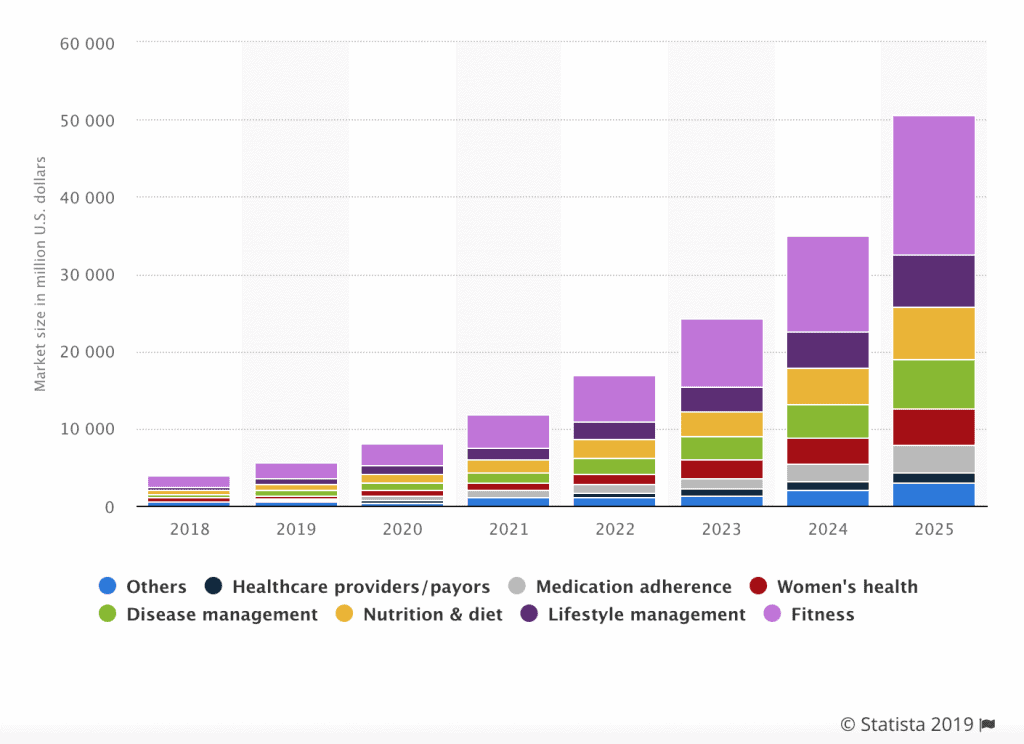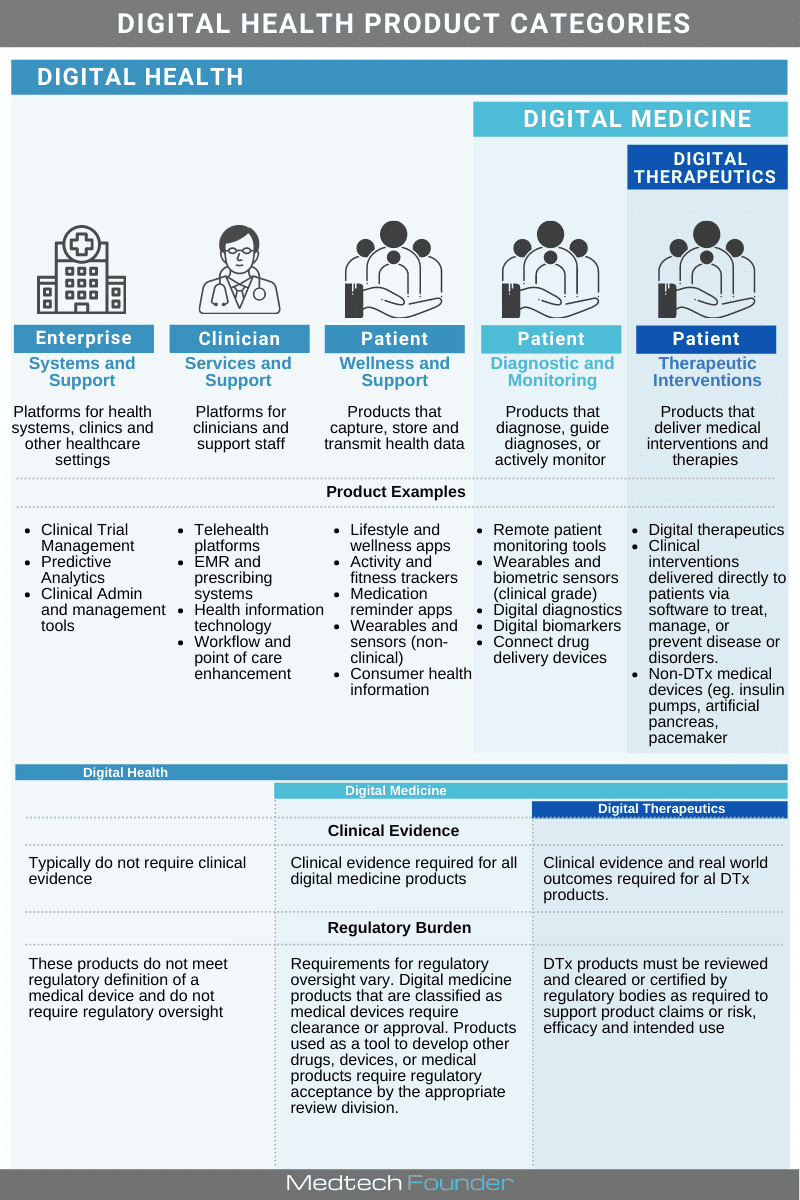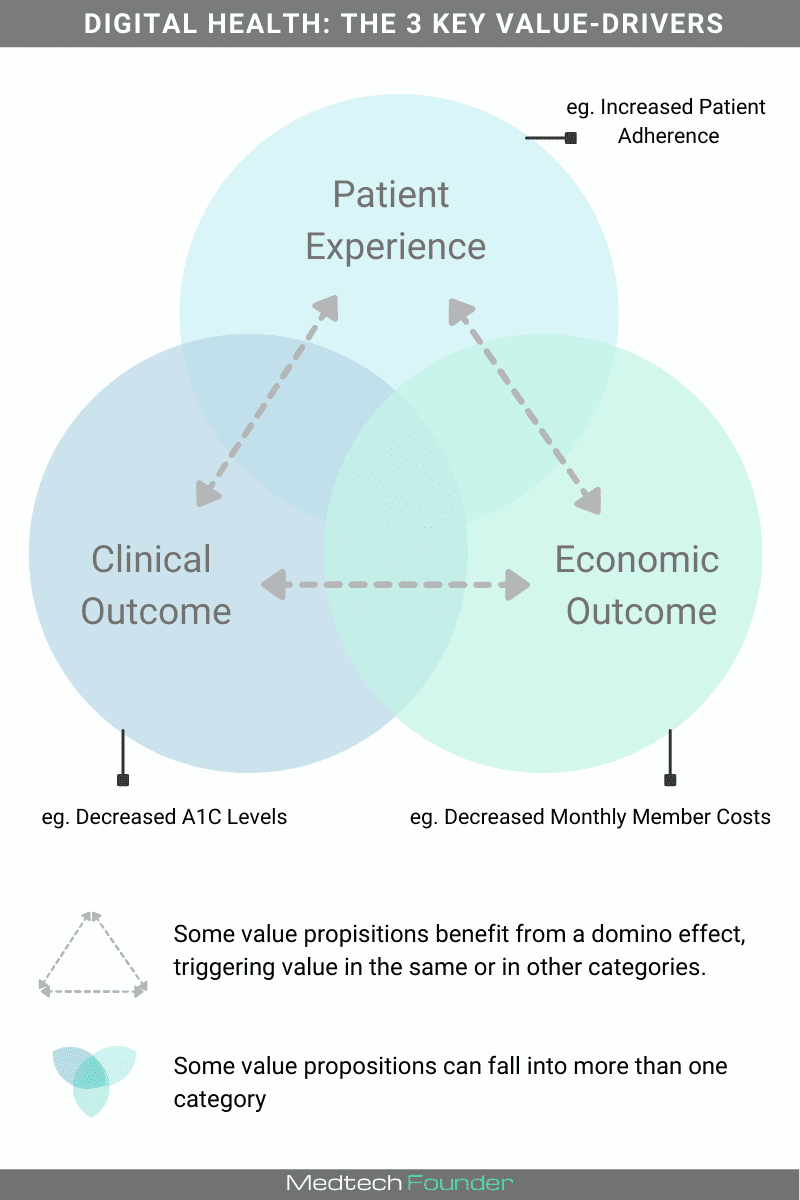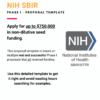Are you building an innovative digital health product? Perhaps you’re working on an inspiring new therapy app or game-changing fitness tracker? I have good news for you. The global digital health and wellness industry is booming and anticipated to surpass 500 billion US dollars by 2025.
Over 325,000 health apps are now available to download2 and 200 more are released each day.1 But despite the volume of services on the market, only a handful of health apps have found significant user adoption
Why is this? And what can digital health providers learn from the success stories?
Our experience working with successful disruptive businesses in health makes it clear that the way in which digital health products are built is just as, if not more, important than the new technology they take advantage of.
By following a few clear steps, you too can start building digital health products that users will love and trust.
In this post, we’ll first walk through some of the key lessons to take from successful products. Then we’ll show you the actionable steps you can take to replicate that success for your own business or practice.
With the right approach to product definition and development, digital health innovators can easily attract the interest of both consumers and high-profile investors, not in a year or 6 months from now, but today.
Let’s get a few things straight first.
The mobile health (mHealth) segment is performing particularly well thanks to the increasing popularity of mobile technologies such as smartphones and wearables. A staggering 85% of Americans own a smartphone, giving them access to a vast array of digital goods and services.
With that kind of reach, it should come as a surprise that over 60% of people claim to have downloaded an mHealth app to enhance their wellbeing and track vital medical statistics.

Source: Statista
Let me walk you through the build process I’ve used, including the 3 key digital health value propositions that should guide all decisions, to build amazing digital health products that patients love.
Table of Contents
What is a digital health product?
Let’s start at the beginning.
This part is important and I’ve seen too many well-intentioned innovators struggle to define, with accurate words, exactly what their vision is.
The digital health landscape is incredibly broad, encompassing simple mHealth apps, health information technologies, telehealth programs, telemedicine, personalized medicine, wearable devices, and digital therapeutics.
Related: How To Get Started In Digital Health? A Comprehensive Guide

Source: DTx Alliance report
A digital health product may harness, amongst other things, the power of cloud computing platforms, specialist software, digital connectivity, or sensors to deliver game-changing outcomes. Furthermore, it may take the form of a medical product, a diagnostic tool, or an adjunct to other healthcare products such as drugs or devices.
Products across the digital health ecosystem serve different but complementary purposes.
The first step is to identify the category of digital health product that you are targeting.
By identifying your category you can begin to define the do’s and don’t of your strategy and exactly how you will be able to build the amazing solution that patients will love.

Depending on the category and your product’s intended use and risk, it is subject to increasing degrees of clinical evaluation, regulatory oversight, and real-world data requirements.
While some technologies such as smoking cessation apps or fitness trackers help patients take control of their own health, others help doctors and other medical professionals make vital clinical decisions. Indeed, rapid developments in artificial intelligence are quickly improving doctors’ abilities to accurately diagnose and treat complex disorders and to enhance healthcare delivery.
But despite technological progress and favorable financial outlooks, an American Medical Association survey has found that fewer than 30% of US healthcare practitioners are actively recommending digital health technologies to their patients and only 13% are actually using them in their practice.
This means that…
The consumerization of digital health technology is largely being driven by users themselves.
While the healthcare practitioner would traditionally have been a user’s first port of call for health information and advice, technology is beginning to change this.
Today, users look to their mobile-first for information on their symptoms, then seek a second opinion from their mobile after they have seen a healthcare practitioner.
When it comes to general health and wellbeing advice, user behavior is starting to shift away from the traditional brick and mortar system to a digital-first approach.
What’s more, improvements in sensor technology suggest that this trend will affect condition management too.
In short… Users are taking matters of their health into their own hands, and they’re expecting you to keep up.

What makes the best digital health products so successful?
So, now you know which products are thriving in today’s market, how can you emulate their success and create a value proposition that patients will love? Successful digital health and wellness products tend to do the following three things well:
Solve patients’ urgent health issues
Creating a profitable digital health product is about addressing complex problems that significantly impact individuals and wider society. Diet and nutrition technologies, for example, play an important role in helping people maintain a healthy weight and stave off chronic diseases. To highlight the scale of the issues, it is worth noting that excess weight accounted for over $480 billion in direct healthcare costs in the US in 2016. By encouraging healthy living via digital technologies, you could help channel this money toward other pressing health problems and boost people’s quality of life.
Personalize patient experiences
Scientists have been promoting the benefits of personalized medicine for several years now, having realized that a one-size-fits-all approach could lead to substandard health outcomes and even misdiagnosis.
Digital health developers have drawn inspiration from the pioneering e-commerce industry in this respect. Personalization has allowed digital product developers across all sectors to thrive, with 88% of American businesses attributing their marketing success to advanced personalization strategies. Tailoring your product, therefore, will boost customer retention and optimize their quality of life.
Offer unbeatable speed and convenience
The always-on culture of today’s digital society has resulted in a widespread taste for quick and convenient services. It should come as no surprise, therefore, that 74% of millennials prefer virtual telemedicine sessions to in-person appointments, a figure that is likely to continue rising.
If you want to cut through the noise and capture those all-important customers, you must alleviate common pain points that cost patients and physicians time and money. Think quick and easy solutions to complex problems – a tough ask, we know, but you will experience unbridled success if you pull it off!
Why are so few digital health services actually winning traction?
Nearly half of all health app downloads were driven by just 41 apps (each had over 10 million downloads). Only 2% of digital health apps have more than 500,000 active monthly users. 86% of all health apps have fewer than 5,000 downloads1. With such a skew, the biggest challenge facing digital health providers is user adoption, engagement and retention.
Many businesses are scrambling to build the next killer app or implement AI, chatbots or wearables into their services.
But our view is that they are funding technology rather than solutions, investing heavily in transient technologies without truly understanding the needs of their users. In many larger organizations, this is compounded by an outdated approach to building and launching new digital products—a process that is often very slow, rigid, and resource-intensive.
Technology has allowed businesses to get closer to their customers than ever before. But many of those businesses are still frightfully distant from the people they’re serving.
Advancement in technology alone won’t help you move the needle on user engagement, nor win the hearts, minds and business of your customers.
The technology is simply redundant unless users adopt it, love it and trust it.
As with most emerging markets, it is startups that are leading the way. To avoid being left behind, larger health providers and incumbent market leaders need to take lessons from their smaller, software startup competitors.
Related: Guide to Building a Digital Health Company in 2023
What are the most popular digital health and wellness products?
Although the digital health and wellness space is wide-ranging and sizeable, it is dominated by a small number of major players. According to stats from IQVIA, almost half of all health and wellness downloads were driven by a mere 41 apps, each of which boasted over 10 million downloads.
To help you understand which digital health companies are defying the odds and thriving in a crowded market, therefore, we’ve collated a list of the most popular examples of digital health products.
As you’ll see, what separates the following products from the rest is the way in which they directly address urgent needs in the healthcare landscape, as well as their endorsements by reliable professionals.
Most of the following companies have been evaluated and approved by the Food and Drug Administrating, and those that haven’t (such as GENERIS) include peer-approved studies and physician testimonials on their websites to engender customer trust.
1. Teladoc
Teladoc operates 24/7 and links patients up with board-certified doctors via audio or video calls. It is a super-convenient app that allows patients to receive near-instant health advice from empathetic and knowledgeable professionals. With a utilization rate 4x the industry average, this platform uses analytics-driven engagement strategies to stave off competition and satisfy customers.
2. mySugr
mySugr helps patients take control of their Type 1 or Type 2 diabetes through special tracking features. After only one month of using mySugr, estimated HbA1c levels in a group of diabetic patients dropped from an average of 9% to 7.8% in one month. Within six months, this figure had dropped to 7.7%. This kind of instant data capture and analysis is perfect for catching medical problems early and avoiding some of the harsher complications associated with diabetes.
3. GENERIS
GENERIS works by using biotechnology companies such as 23andMe to create health disposition reports about everything from G6PD deficiency to late-onset Alzheimer’s disease risk. The app analyzes over 50 genetic markers to come up with wellness suggestions, making it the go-to app for DNA-based advice. What’s more, GENERIS supports every claim it makes using scientific data drawn from peer-reviewed journals, meaning users rest assured that the recommendations they receive are well-informed.
4. Gauss
Gauss allows doctors and nurses to measure blood loss during surgical procedures using a simple smartphone application. Medical professionals need only take a photo of the surgical sponges used during surgery, and the app will calculate how much blood the patient has lost in real-time. This app has proved so valuable to physicians that its developer won a prestigious Apple Design Award in 2018.
Other influential players
Looking to find out more about other companies disrupting the digital health and wellness space? Check out the following big names:
How to think like a designer when building your digital health product
Whether you are starting out or are working within a large organization you can successfully apply a startup-oriented approach to building great products.
What’s more, the scale, reach and resources in larger organizations provide a real opportunity to change the industry, improving health outcomes, reducing healthcare costs, and creating new business streams.
But everyone, regardless of what stage you are in, needs to adapt to the new reality, fast.
User needs are more important than technology trends
If you task your team with finding a way to take advantage of an exciting new technology and integrate it into your service, the results will likely fall short of expectations.
Instead, you need to focus on how the technology can support real human needs and behavior.
Instead of looking for innovative ways to squeeze a new technology (such as a chatbot) into your services, you should instead speak to users first and understand specifically what their needs are. Then build apps that address these needs.
To address user needs, you need to think like a designer
Tim Brown, co-founder of IDEO and a prominent spokesperson for the potential of great design, writes:
“During the latter half of the twentieth century design became an increasingly valuable competitive asset in, for example, the consumer electronics, automotive, and consumer packaged goods industries. But in most others, it remained a late-stage add-on. Now, however, rather than asking designers to make an already developed idea more attractive to consumers, companies are asking them to create ideas that better meet consumers’ needs and desires. The former role is tactical, and results in limited value creation; the latter is strategic, and leads to dramatic new forms of value.”
Design is not about making things look pretty. Design is fundamentally about solving problems
Principles for minimum viable prototyping
So we’ve come up with a few basic principles, based on multiple experiences with minimum viable prototyping
- Pick the simplest tool that will allow you to get a prototype out there.
- Favor tools that will allow you to iterate rapidly (in seconds, not minutes), particularly at the early stages of prototyping.
- Pre-book test groups and limit yourself with tight deadlines, so that you’re forced to prototype quickly
- Don’t prototype ambitious concepts–as soon as you have just enough of a prototype to test with users, go and run that test.
- Push back on ‘polish’. A prototype is supposed to be unfinished. As long as users can grasp what you’re showing them, the visual finish doesn’t matter.
We all know that prototyping is a big deal. If you’re even remotely in tune with startup literature and holy gospel, you’ll have read The Lean Startup and be putting those principles into place wherever you can.
We all know that getting great user feedback is what keeps us on track when we’re building products. For that, we need prototypes!
But are we doing the prototyping as effectively as we could be? Wikipedia defines a prototype as:
An early sample, model, or release of a product built to test a concept or process or to act as a thing to be replicated or learned from.
Prototyping tools
At Medtech Founder, we’re always looking for new tools to speed up our prototyping. There are some great apps like POPapp and Marvel–both of them are fantastic and allow you to turn simple sketches and mock ups into fully-clickable prototypes in order to gather feedback.
We’ve used them on plenty of projects.
In addition, you can consider InVision, Figma, or to create fairly high-fidelity prototypes, Flinto is another option. For more details check out Net Options’ full review of prototyping tools.
Google Slides is not a polished app that’ll help you build out beautiful, realistic prototypes. it’s definitely not cool. But it might well be the best tool for the job.
Yup, you read that right. Let’s talk about how Google Slides might be an even faster prototyping tool than pen and paper.
Google Slides enables collaboration across remote teams, features internal linking and is extremely fast to work with. If your goal is to get going and you’re already pretty handy with it, you can wield it to great effect for rapid prototyping.
Build a Digital Health Prototype in 5 days
Is your proposal for a genius new healthcare product starting to take shape? Here’s how to plan, develop, and build your idea into existence in 5 days.
The 5 day sprint
On all of our 5-Day sprints, we make use of the Design Thinking mentality and workflow.
We use a system that allows us to very rapidly explore a problem, build prototypes, and validate these. Of the 6 stages in the design thinking process, we aim to complete the first 4 in days 1-2 of a sprint, and then move on to prototyping for the remainder of the week.
It’s hard to do justice to the amount of ground that can be covered in 3 days. You can build and iterate through multiple prototypes (shoot for up to 1), get in front of test users for interviews for each one, and speak to another 15.
Here’s the super simple guide:
Day 1 & 2: Building our understanding and coming up with ideas
Days 3 to 5: Prototyping and Validating
Now comes the part where we finally get to start thinking with our hands and dive into prototyping.
By day 3, you should have a strong understanding, a solid idea to begin with, and everything you need to get started.
Consider lining up a remote user testing session with a group of test users. Let them know that this is simply a prototype that you’re seeking feedback on.
Here’s an example of a low‑fidelity prototype built-in Google Slides that was used to kick off conversation topics with a user. It doesn’t need to get much fancier than this to be useful.

The Best Digital Health Software Development Partners
So you’ve made some quick progress with your minimum viable prototype. You’ve been able to get your ideas from your head into something tangible. That’s a great first step.
Unless you are a developer yourself, you’re going to need some help with the next part – getting the actual functionality you need in a real software product.
Even if you have the software skills to pull it off, you should probably stay focused on developing your business concept, launch strategy, fundraising, partnering, hiring, and a million other things.
The best use of your time at this point is to:
1) Quickly hire a developer for this project OR
2) work with a software development company.
Efficient hiring is absolutely critical to building a business, especially in the early phases. You don’t want to rush this process. Whether you plan to hire someone full-time or on a contract basis you’ll end up with a single person to execute your vision.
The alternative, which I recommend, is to find a software development partner that can bring a full team to the project and will take it as far as you need without any strings attached.
Almost all software development companies will tell you that they have a ton of experience in healthcare. It’s hard to cut through the noise.
I’ve gone through this process multiple times. You want a team that understands how the work with founders, is flexible, and responsive but also brings the right expertise to the table.
You’ll want to avoid working with “full-service”, multi-industry software consulting firms. They are expensive and want to make money advising your business rather than lower-margin software projects.
Here’s a shortlist of healthcare-focused software development partners that we’ve personally vetted for working with small, focused teams just starting out.
1. Apzumi
Some previous projects include Chanl Health’s virtual cardiac rehab program and Harvard affiliated Global Second Opinion, a telemedicine platform for cancer patients and their families that seek an international medical second opinion on their cancer diagnosis and treatment
2. Arkenea
Telemedhome is a highly intuitive interface to help users focus on keeping track of their health with timely reminders and remotely monitor high-risk patients with chronic diseases. Feelya is a telemedicine platform that patients can book online therapy sessions with psychologists and psychotherapists.
3. Empeek
Remote patient monitoring and EHR and telehealth integration for a mid-size hospital system.
4. Matellio
Matellio is a midsize company that is starting to diversity. They have deep expertise in various areas including AIML and can build apps, e-prescription, EHR, and revenue cycle management software.
5. Taazaa
These guys are really focused on design and getting the UX right. They engaged in areas outside of healthcare as well, but something like 50% of their business is healthcare. They work with a lot of startups and don’t try to overcharge. Previous projects include Telehealth And Remote Patient Monitoring as well as a Healthcare platform for medication monitoring.
The bottom line
There you have it – a beginner’s guide to building an amazing digital health product. If you have a groundbreaking idea that could transform the world of digital healthcare, there’s never been a better time to make it a reality. Just remember to put your target users first, and don’t give up when the going gets tough!






Here is world’s best health and digital product. For more information, click here.